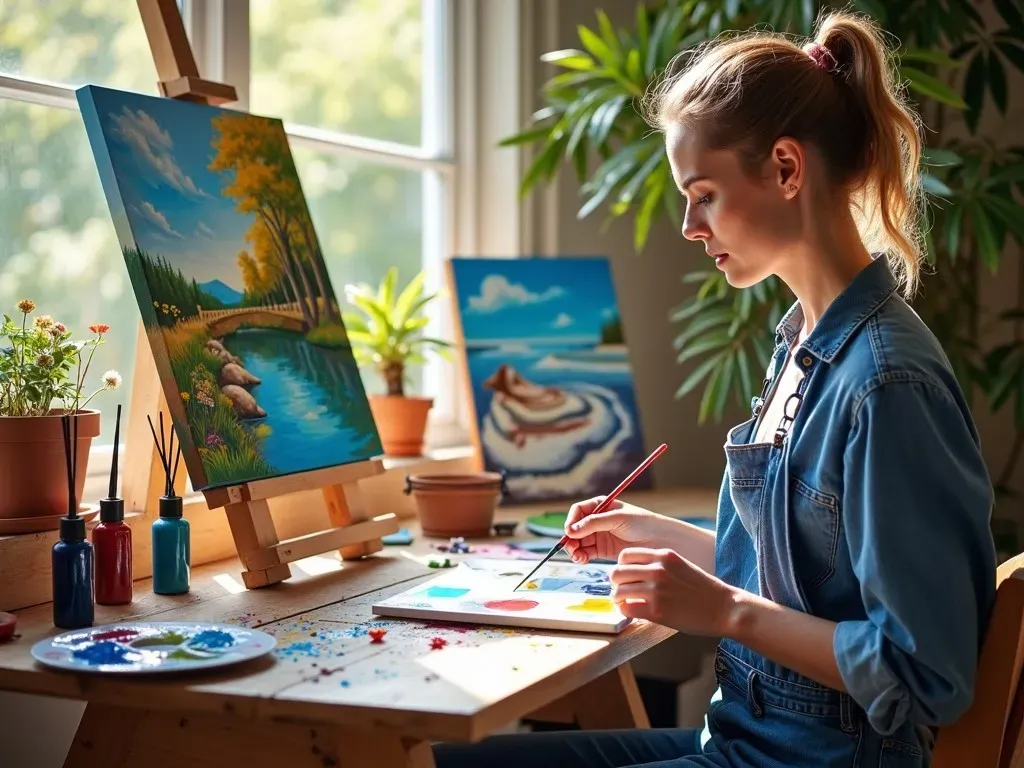Easy oil painting ideas are just what you need to unleash your inner artist and create beautiful pieces, even if you are just starting your journey into the world of oil painting. Whether you’re a complete novice or someone looking to refine your skills, there are countless simple projects that can ignite your imagination and bring a sense of accomplishment. Let’s explore a variety of easy oil painting ideas that cater to beginners, covering different themes, styles, and Techniques.
Easy Oil Painting Ideas to Get You Started
Here are simple oil painting ideas perfect for beginners looking to dive into creativity while having fun.
-
Fruit Still Life
- Painting colorful fruits like apples or bananas is a great way to practice blending techniques.
- Use bold colors to make your fruit stand out.
-
Floral Arrangements
- Simple flowers such as daisies or sunflowers can be painted easily.
- Focus on capturing the essence of the flower rather than intricate details.
-
Abstract Color Experiments
- Allow yourself to play with different colors and brush strokes to create unique abstract pieces.
- This is a perfect opportunity to learn about color mixing.
-
Sunsets and Sunrises
- Capture the beauty of nature by painting a simple sunset scene using warm colors.
- Practice blending colors to depict the sky’s gradient.
-
Ocean Waves
- Paint the ocean using varying shades of blue and white for foamy waves.
- Focus on the fluidity of your brush strokes to capture movement.
-
Mountain Landscapes
- Start with a basic mountain silhouette and add layers of color for depth.
- Use a palette knife to create texture on the mountain surfaces.
-
Cuddly Animals
- Try your hand at painting an easy version of a cat or dog.
- Use soft brushes to achieve a fluffy effect.
-
Simple Clouds
- Experiment with painting clouds by using a light blue background and white paint to create soft, fluffy clouds.
- Vary the sizes to add realism.
-
Simple Trees
- Use shades of green and brown to depict trees.
- Experiment with brush techniques to make leaves look realistic.
-
Starry Night
- Inspired by Van Gogh, create your starry sky using bold colors to represent stars and swirls.
- Focus on brush strokes to capture movement.
Easy oil painting techniques for Beginners
While brainstorming your painting ideas, familiarize yourself with basic techniques that will make your paintings more vibrant and appealing. Here are some useful techniques to note:
| Technique | Description |
|---|---|
| Glazing | Applying a thin layer of transparent color on a dried layer. |
| Impasto | Thick application of paint to create texture. |
| Wet-on-Wet | Applying wet paint onto wet paint for blending effects. |
| Blending | Mixing colors directly on the canvas for smooth transitions. |
| Dry Brush | Using a dry brush to add texture or highlights. |
Popular Painting Subjects for Beginners
- Landscapes: These can include mountains, rivers, forests, and more. Opportunities to capture the nuances of nature make this a rewarding project.
- Animals: Pets or wildlife scenes can be very engaging to paint.
- Still Lifes: Arrange a few objects such as fruits, flowers, or household items to create a vibrant composition.
- Self-Portraits: A great exercise in capturing likeness and exploring colors.
- Seasonal Scenes: Capture the essence of the seasons through landscapes, like autumn leaves or summer blooms.
Tips for a Successful Oil Painting Experience
- Choose Quality Paints: High-quality oil paints will yield better results than lower-quality ones, making it easier to achieve your desired effect.
- Use Good Brushes: Invest in a few decent brushes with varying shapes and sizes. This versatility can greatly enhance your painting.
- Practice Color Mixing: The ability to create new colors through mixing can expand your palette significantly.
- Work in Layers: Allow each layer of paint to dry before adding more. This method helps in achieving depth in your work.
- Don’t Rush: Enjoy the process and take your time. The aim is to have fun and learn along the way.
Resources for Further Learning
If you’re eager to learn more, several online tutorials and resources can help you:
- Art Ignition – Provides step-by-step guides for beginners on easy oil painting ideas.
- Fine Art Tutorials – Offers insights on techniques and styles, along with tutorials.
FAQ
What materials do I need to start oil painting?
You will need oil paints, brushes, a palette, a canvas, linseed oil (or other mediums), and turpentine for cleaning your brushes.
How long does it take for oil paint to dry?
Oil paints can take anywhere from a few days to several weeks to dry completely, depending on the thickness of the paint and the environment.
Can I use acrylic paint instead of oil paint?
While acrylic paints are a different medium, they also offer vibrant colors and flexibility. However, they have different drying times and require different techniques.
Is oil painting suitable for kids?
Yes, oil painting can be suitable for older children under adult supervision due to the use of solvents, but it’s advisable to use non-toxic materials.
These easy oil painting ideas and tips will pave the way for a fulfilling painting experience. Embrace your creativity and let your imagination flow as you start painting your first masterpieces!
